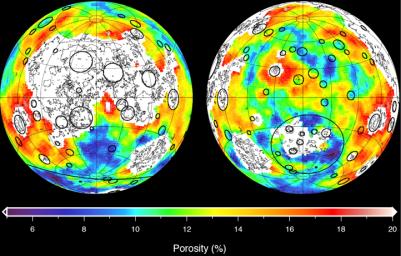
|
Closer Look at Lunar Highland Crust
- Click the image above for a larger view
- Full-Res JPEG (1440 x 919) (312.4 kB)
- Full-Res TIFF (1440 x 919) (4.0 MB)
Caption:
This image depicting the porosity of the lunar highland crust was derived using bulk density data from NASA's GRAIL mission and independent grain density measurements from NASA's Apollo moon mission samples as well as orbital remote-sensing data. Red corresponds to higher than average porosities and blue corresponds to lower than average porosities. White denotes regions that contain mare basalts (thin lines) and that were not analyzed.
The 12 percent average porosity of the highland crust is a consequence of fractures generated by billions of years of impact cratering. The crustal porosities in the interiors of many impact basins are lower than their surroundings, a result of high temperatures experienced at the time of crater formation. In contrast, the porosities immediately exterior to many impact basins are higher than average as a result of fracturing by impact-generated shock waves and the deposition of impact ejecta.
Background Info:
NASA's Jet Propulsion Laboratory in Pasadena, Calif., manages the GRAIL mission for NASA's Science Mission Directorate in Washington. The Massachusetts Institute of Technology, Cambridge, is home to the mission's principal investigator, Maria Zuber. GRAIL is part of the Discovery Program managed at NASA's Marshall Space Flight Center in Huntsville, Ala. Lockheed Martin Space Systems in Denver built the spacecraft. The California Institute of Technology in Pasadena manages JPL for NASA.
For more information about GRAIL, please visit http://grail.nasa.gov .
Cataloging Keywords:
| Name | Value | Additional Values |
|---|---|---|
| Target | Moon | |
| System | Earth | |
| Target Type | Satellite | |
| Mission | GRAIL | |
| Instrument Host | GRAIL | |
| Host Type | ||
| Instrument | ||
| Detector | ||
| Extra Keywords | Color, Crater, Impact | |
| Acquisition Date | ||
| Release Date | 2012-12-05 | |
| Date in Caption | ||
| Image Credit | NASA/JPL-Caltech/IPGP | |
| Source | photojournal.jpl.nasa.gov/catalog/PIA16588 | |
| Identifier | PIA16588 | |
